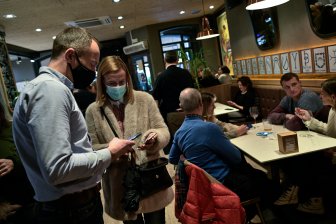For Dr. Laura Hawryluck, one of the challenges of working in a strained health-care system is no longer having the time to personally relate to patients.
Under constant pressure due to COVID-19 and staff shortages, Hawryluck said hospital workers are forced to become more task-oriented, doing what they must to keep patients alive and losing the time to really understand them.
Throw the Omicron variant into the mix, and health-care workers are finding themselves in a situation of “dread mixed with a lot of worry” that hospitals will once again fill up with COVID-19 patients, Hawryluck said.
“The worry is that having navigated now four waves of this — and this going to be our fifth one by our count — we’ve lost a lot of staff and people have been working all kinds of hours and redeployed situations,” said Hawryluck, a critical care doctor in Toronto.
“(It) has us, frankly, very concerned over whether or not we’re going to be able to provide the level of help that we want to.”
A stretched health-care system
Canadian health-care workers have been on the front lines throughout the pandemic, dealing with four waves of COVID-19 patients flowing through the hospital system.
At several points in the pandemic, provinces have had to send in requests to the federal government for help with hospital staffing. Most recently, Manitoba put in a formal request for additional intensive care unit (ICU) staff to help alleviate its stretched-out system.
This relentless trend has led to industry-wide burnout, exhaustion and staff shortages. According to Statistics Canada, earlier this year nearly one in five job vacancies in Canada was in health care and social assistance; those sectors experienced the largest losses year over year compared to all other sectors.
“Our health-care workers are exhausted and they’re working under very challenging circumstances right now, even before Omicron,” said Dr. Tasleem Nimjee, an emergency physician in Toronto.
“That’s a challenging environment to work in, and now you’re layering this on top of that.”
Governments have faced pressure throughout the pandemic to invest more money into health care and to come up with detailed plans that include how to recruit, train and retain workers to replace those who have left.
In November in Ontario, the government announced as part of its fall economic statement that it’s investing $342 million to add and upgrade the skills of more than 5,000 registered nurses and registered practical nurses and 8,000 personal support workers.
Another $57.6 million will go toward hiring 225 more nurse practitioners in long-term care, starting next year.
In Manitoba, the government announced Wednesday it’s investing $19.5 million to add 259 nurse training seats at five post-secondary institutions across the province as part of its multi-year plan to add roughly 400 seats over the next few years.
There are more than 800 nursing seats currently offered at six publicly funded post-secondary institutions across the province, officials said Wednesday.
With Omicron spreading in Canada, governments must make further investments to boost hospital capacity in anticipation of another surge, said Linda Silas, president of the Canadian Federation of Nurses Unions.
“The shortage of health-care professionals is at a crisis stage, and that’s why doctors, specialists and surgeons, are advocating to hire more nurses and put more funding to help (ease) these (surgery) wait times,” she said.
“What we need is a strong national strategy with targeted funding to retain and recruit nurses, health-care workers and really bring stability in our workforce.”
In its throne speech last month, the federal government promised to help improve health-care systems and alleviate surgery backlogs.
Health Minister Jean-Ives Duclos acknowledged on Nov. 30 that there is “a lot of work to do.”
“Our understanding is that those delays are being reduced slowly because the pandemic is relatively under greater control than it was a few months ago,” he said. “We know one of the priorities is exactly that — to handle backlogs in surgeries.”
As Omicron spreads in Canada, officials have been introducing measures to slow its spread. The Public Health Agency of Canada projected if Omicron becomes the dominant strain of the virus in the country, cases will skyrocket by the new year.
Ontario, which is among the leaders in Canada’s COVID-19 resurgence, logged 2,421 new cases on Thursday. However, patients with COVID-19 in ICUs have remained relatively stable, but are overall on a slow rise.

Provincial health experts projected Thursday that unless community contacts are significantly reduced, the province’s ICU capacity could be severely strained by early January.
As we come to learn more about the variant, thinking about an Omicron-led surge is inducing anxiety, said Silas.
“When you work in an intensive care atmosphere, and now the whole health-care system is in that intensive care atmosphere where it’s go, go, go, you need breaks and they haven’t had breaks for 22 months,” she said.
“Everyone was looking forward to getting at least some time off, and that looks like it’s going to be cancelled for everyone.”
For months, it felt like society was starting to get back to somewhat pre-COVID-19 normalcy, Nimjee said, but quickly adjusting to this new reality, especially with the holidays around the corner, is tough.
“It takes a while to almost relax and fall back into that, and then to shift back out of that so quickly … it’s hard,” she said.
“But what we have to do it, we got to do it, so that’s what we’re going to do.”
As for Hawryluck, she pleads for Canadians to stay safe during the holidays and to get vaccinated.
“I can’t tell you how hard it is to watch somebody struggle to breathe, to watch somebody struggle to breathe even on a ventilator, to not know if they’re going to live from day to day, hour to hour sometimes, and to have to convey that news to a family, it is heartbreaking,” she said.
“If we as a group of people … can do things that help prevent us from getting there, even if that prevention is not 100 per cent effective, it’s worth it.”
— with files from Jamie Mauracher and The Canadian Press
© 2021 Global News, a division of Corus Entertainment Inc.








More Stories
Global measles cases nearly doubled in one year, researchers say
How to make conversations with aging parents a little less awkward | CBC Radio
N.S. mom calls for better ultrasound access after private clinic reveals twins | Globalnews.ca